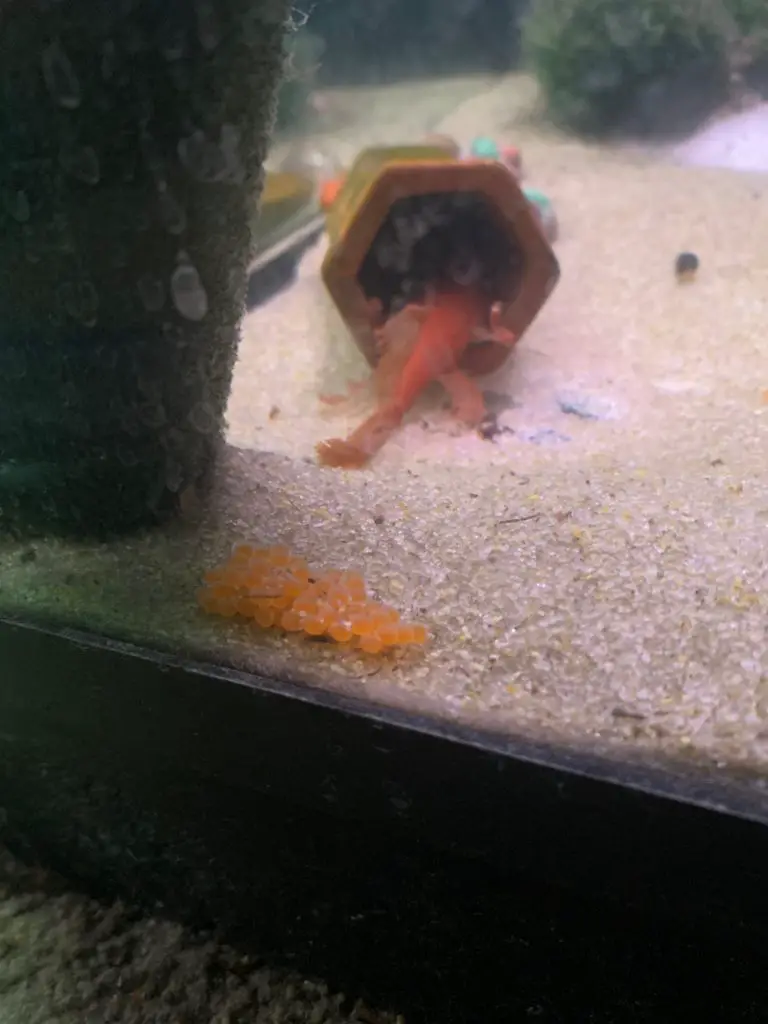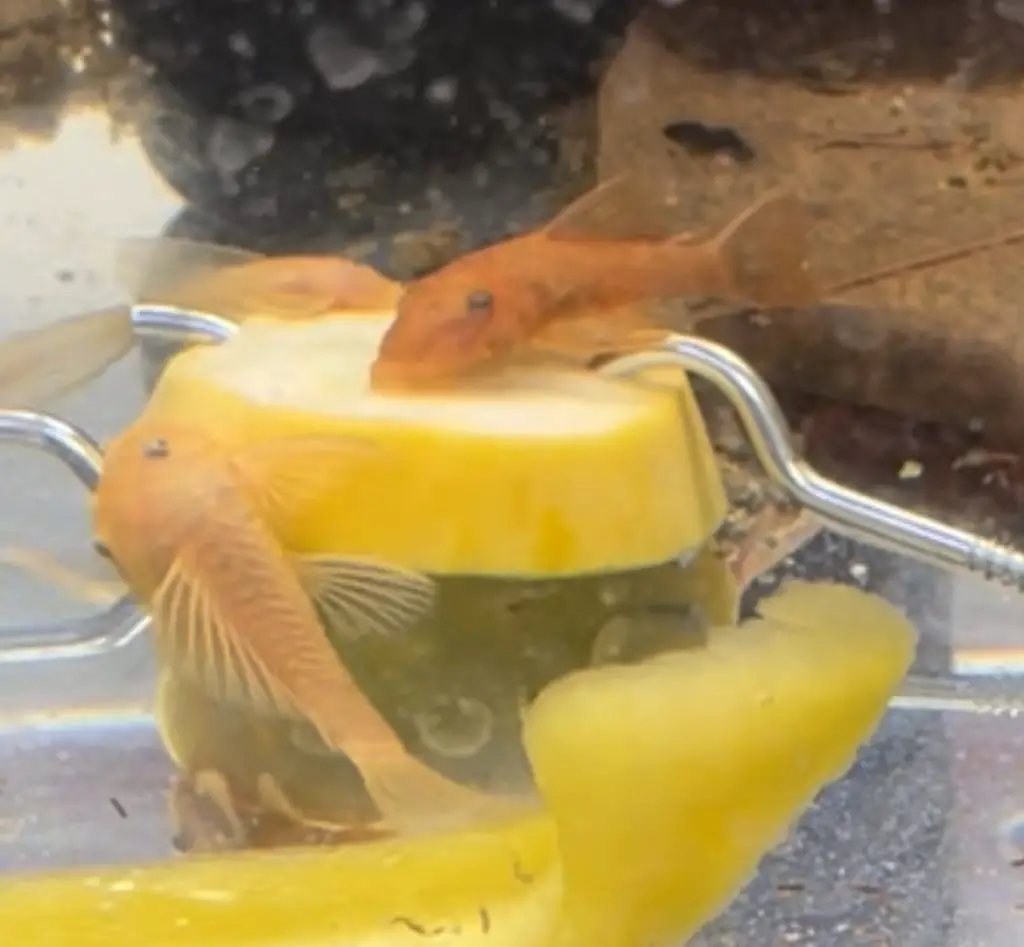Your Pleco had eggs now what? How do you take care of these pleco eggs?
Regardless if your plecos surprised you with a batch of eggs or if you were trying to breed your plecos
Having your plecos, lay eggs is a very exciting time.
How to care for these eggs is the next step and for the most part, it’s actually quite easy.
So let’s talk about those times when it doesn’t go as planned or if you have a pleco dad that’s still learning his job as the main caregiver and protector.
What do fertilized pleco eggs look like?

First, let’s make sure that the eggs are even fertile. Most plecos eggs are yellow when fertilized.
There are a few exceptions like the l046 zebra plecos eggs are white but they are a rare exception to the rule.
Pleco dads are usually quite good fathers. They are excellent at protecting and raising their offspring and need little interference.
When your plecos have eggs they will be clumped together in a clear egg casing that the dad can stick to objects to keep them in place.
Usually a wall of the cave of his choosing, but if the eggs are out of the cave and not being cared for by the dad you become the caregiver and will need to look out for unfertilized eggs in the bunch.
Can pleco eggs get fungus on them?
Because they often will fungus over and could kill the whole batch.
There are several ways you can help the eggs from fungusing over.
The most important step to make sure the eggs don’t get fungus on them is having water movement around the eggs so there is always fresh water and oxygen for the eggs.
This can be achieved by putting eggs in a breeder box, bowel, or small tank, and then by using an aquarium air pump you can create water movement.
The eggs don’t need to move or bounce around like some fish eggs. As long as there is water movement they will be fine.
Another way to stop eggs from fungusing over is to treat the water with methane blue. This is used for treating several illnesses that fish can get and one of them is fungal infections.
So naturally, it is great at killing fungus on eggs as well.
When using methane blue you will want to make sure you are using a container or tank that you are ok with getting stained blue.
Like the name, the color of this medication is blue and will turn your water blue. The glass on your tank will be fine but the silicone will be stained.
One other important thing when using this method is that once the babies hatch you will want to do daily 50% water changes to tell the tank water has returned to a clear color.
Baby fish are more susceptible to chemicals and methane blue can kill or harm them if exposed to it for an extended period of time.
These methods, while very effective are in no way a guarantee that the outcome will be perfect but will go a long way to preventing pleco eggs from fungusing over.
How to remove dead eggs or eggs that have fungus on them
Sometimes not all of the eggs were fertilized or for various reasons a few eggs may die.
When this happens you will need to remove them from the bunch. While this isn’t hard to do but it can take some patience since the eggs can be a little slippery. Usually, the best way is to use 2 sets of tweezers to pull it out.
One trick that a few pleco breeders use is putting a few shrimp in the tank or container. They will eat the fungus off of the eggs and will leave the healthy eggs alone.
Why did my pleco male kick the eggs out of the cave?
Sometimes the male has kicked the eggs out of his cave. This can be for several reasons.
Most of the time it’s a new pleco dad. He is still learning how to take care of the eggs. Usually, after a few batches of eggs he figures it out.
Another way this happens is the female lays an extra large batch of eggs and in the process of her leaving the cave part of the batch or clutch gets knocked out.
Also if you have multiple females in your tank they sometimes may try to lay eggs with the same male and since he is already on a batch of eggs he will kick them out.
This is one reason you will need to make sure they are fertilized. If the female lays eggs but the male doesn’t fertilize them. No matter what you do the eggs won’t hatch.
Most males will usually fertilize the new batch of eggs but may be unable to take care of both and kick the new batch out.
You know you have a good pleco dad when he can take care of both batches at the same time.
Lastly, you may have a male that isn’t good at raising young and will kick out every batch after he fertilizes them.
Then you are stuck raising all of his babies. Luckily this isn’t hard to do and depending on the species of pleco it may not be an option to replace the male.
After you have the eggs in an environment that is conducive to the eggs hatching it is a waiting game.
How long does it take for pleco eggs to hatch?
Depending on the breed of pleco and how warm the tank is will determine how long the eggs take to hatch. It usually takes 4-10 days for the eggs to hatch.
Since the egg casing is clear you can watch your future babies develop. During the time that the eggs are developing, you can start to see little eyes appear and a tail starts to develop.
Up to the point where the eggs hatch. Pleco eggs are a little different from what most of us are used to when an egg hatches.
Most of us think of some kind of birds hatching and being fairly developed but with pleco babies, their head and tail detach from the egg yoke allowing them to move around.
While the belly stays attached to the egg yolk. This allows the baby plecos, also known as fry, to start developing their muscles and a constant food source during the time when they are protected in the cave.
If you are artificially hatching these eggs then you will get to experience them beginning to move around and finish developing.
Once you have arrived here you no longer have to worry about them having problems with fungus and are over the first hurdle of raising your own baby plecos.
Related Articles
Can my plecos eat leafy vegetables?
Best tank makes for predator and monster fish tanks

